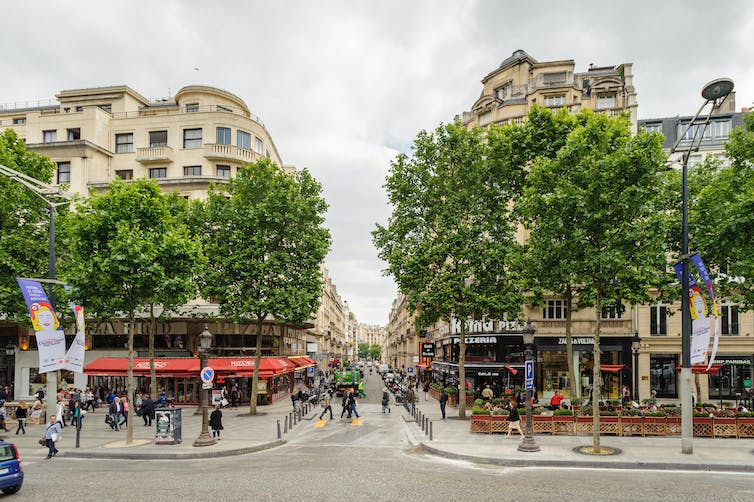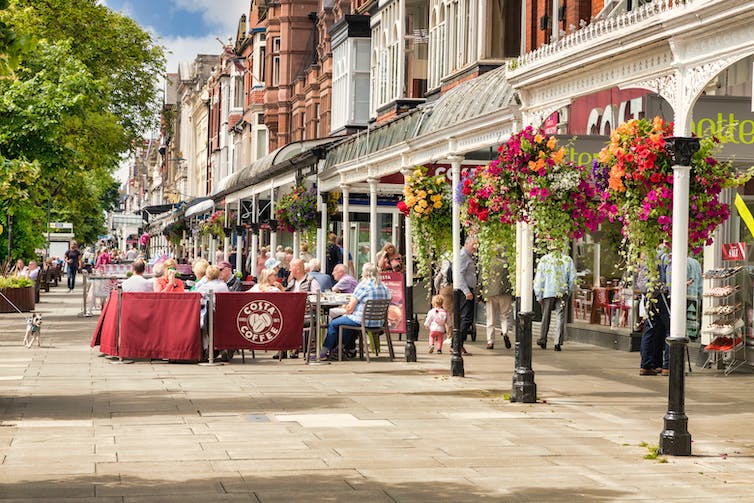![]() Conspiracy theories aren’t a new thing, and for as long as they’ve been around they’ve ranged from the benign to the absurd. From the six moon landings being faked to the Earth being flat, or our ruling class being lizards, we’ve all probably come across them in one form or another.
Conspiracy theories aren’t a new thing, and for as long as they’ve been around they’ve ranged from the benign to the absurd. From the six moon landings being faked to the Earth being flat, or our ruling class being lizards, we’ve all probably come across them in one form or another.
Yet, in a surprise twist, the hottest conspiracy theory of 2023 comes from an unlikely corner: town planning. This relates to the idea of “the 15-minute city” and has even gone so far as to be mentioned in UK parliament by an MP who called the idea “an international socialist concept” that will “cost us our personal freedom”.
As town planning academics who have published research on 15-minute cities, we know this is nonsense. But what actually is the 15-minute city? And what’s the fuss about?
The 15-minute city itself is a simple idea. If you live in one, it means that everything you need to go about your daily life – school, doctors, shops and so on – is located no more than a 15-minute walk from your house.
Designed for people not cars
The concept, which originated from the French-Colombian urbanist Carlos Moreno, is the current zeitgeist in planning, and calls for city design that is centred on people and their needs rather than being designed for cars. It gained international attention when the mayor of Paris, Anne Hidalgo, announced her intention to make Paris a 15-minute city following her reelection in 2020, with the plan to enhance neighbourhoods across Paris while ensuring connections between them. The idea flourished in the wake of COVID, when lockdowns and working from home had more of us ditching the car and recognising the need for well-served local neighbourhoods.

Yet this connection to how our towns and cities are changing in the wake of COVID is also probably the reason that 15-minute cities are now a hot-topic in the conspiracy world. Among other things, the charge sheet against 15-minute cities is that they are a “socialist”, or even “Stalinist”, attempt to control the population by actively preventing citizens from straying more than 15 minutes from their homes.
However, the reality is that the 15-minute city does not seek to exclude people or to prevent them from leaving. Instead, the idea is about providing high-quality neighbourhoods so that you don’t have to travel further to get the service. Crucially, this doesn’t mean you’re trapped where you live.
Yes, if travelling by car, the 15-minute city might make the journey to leave the neighbourhood longer as the urban realm and roads shifts from car dominance to a more equal distribution of space for active travel. But this might also mean that other ways of getting about town (walking, wheelchair, cycling, bus or train) might make sense for most journeys, with the car used only when necessary.
It’s fairly easy to see how Moreno’s idea has been perverted here. Within this, it’s also equally easy to trace a line between this and the prevalence of conspiracy theories surrounding COVID and the role of government. In this world, encouraging us to use cars less is seen as a limitation of our freedom rather than an opportunity to live in more vibrant and less polluted neighbourhoods.

The thing is, like so many other conspiracy theories, it gets into trouble when it comes into contact with reality. In many British cities, the reality is that having most services within a 15-minute walk of your house is already closer than you might think – what matters more is the quality and equity of those services.
Most people want things nearby
What’s more, these ideas are popular. Not only have organisations like Sustrans consistently shown that more than two-thirds of people are in favour of these sorts of interventions, they are also endorsed at the ballot box. For example, when some candidates attempted to turn local council elections into a referendum on active travel interventions, they largely failed to get this opposition off the launchpad.
If anything, the 15-minute city envisages even the most urban parts of the country as something quintessentially British: a small market town. Indeed, if harking back to the past is your thing, then the past 50 years of transport planning has done more to damage this British ideal than make it a reality.
In fact, you would imagine that the Conservative MP who raised this conspiracy theory in the House of Commons might regularly get correspondence from the public bemoaning the lack of high-quality services in their neighbourhoods.
After decades of car-dominated culture there is a “gear change” happening in which pedestrian and cyclist experiences do increasingly matter in city planning. There is still a long way to go to make our streets and neighbourhoods places for all, and movements fuelled by conspiracy theory risk slowing these transitions and spreading unjustified fears.
While the 15-minute city has nothing to do with creating ghettos where people will be locked in, fake news like this circulates broadly and quickly, making it crucial for policymakers to convey clear messages about what’s at stake.

Don’t have time to read about climate change as much as you’d like?
Get a weekly roundup in your inbox instead. Every Wednesday, The Conversation’s environment editor writes Imagine, a short email that goes a little deeper into just one climate issue. Join the 10,000+ readers who’ve subscribed so far.![]()
Alex Nurse, Senior Lecturer in Urban Planning, University of Liverpool; Alessia Calafiore, Lecturer in Urban Data Science and Sustainability, The University of Edinburgh, and Richard J. Dunning, Senior Lecturer in Housing and Planning, University of Liverpool
This article is republished from The Conversation under a Creative Commons license. Read the original article.
Source Link: 15-Minute Cities: How To Separate The Reality From The Conspiracy Theory